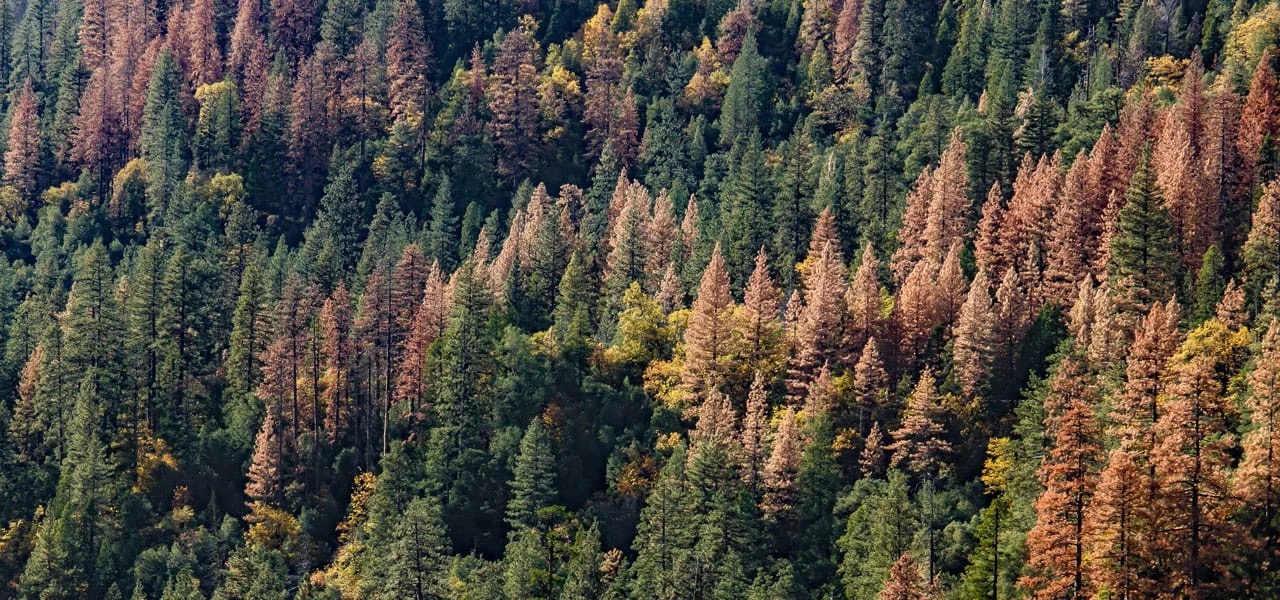At a Glance
Height: 50 to 80 feet tall
Spread: 30-60 feet
Shape: Young trees are columnar, older trees spread out and have heavy, wide-spreading branches
Exposure: Full sun
Native? Yes
Evergreen? No
Leaves: 3 to 6 inches long and wide, triangle or heart-shaped, coarse-toothed, dark green
Fruit: Catkins in the early spring, female trees have green capsules that split and release clouds of seeds (the “cotton”) in early June
Firewise? No
Drought-tolerant? Moderately – a long-term drought will kill them
Bark: Young trees have yellow-green thin, smooth bark, older trees have a thicker (up to 6 inches) gray bark with vertical ridges
Where to Plant: Will tolerate different kinds of soils as long as they are well-drained. Requires full sun. The roots are far-spreading. They should not be planted near wells or underground water pipes.
Common Problems & Possible Causes
Cracked, dying bark or oozing white foam – Slime Flux
Yellow spots and sticky residue on leaves – Aphids
Cracked cankers, discolored bark or oozing resin – Cytospora canker
Honeydew excretion, incredibly small insects on the underside of leaves – Scale insects
Beetle Borers
Thrips
Anthracnose
Crown Rot
Mistletoe
Sooty Mold

From left to right, a plains cottonwood leaf, a narrowleaf cottonwood leaf, and a lanceleaf cottonwood leaf.
About All Cottonwood Trees
Cottonwood trees are a common street tree, and are the largest native broadleaf trees in Colorado. Their wide-spreading roots are helpful in reducing erosion and slowing floodwater runoff. They are also a popular habitat for various forms of local wildlife.
Cottonwoods get their name from the white fluff that floats off the trees; these resemble cotton and contain the tree’s seeds.
Due to the snow-like seeds, brittle branches that break easily, and suckers that pop up everywhere, many cottonwoods are considered “messy” trees.
Though some cottonwood trees can live over 100 years, many in urban areas only have a lifespan of around 30 years.
Many communities in the Denver metro area have banned the planting of cottonwood trees because of their large size and invasive root systems. On smaller properties, they just don’t have enough room to grow. Their roots are strong and can break into plumbing lines (especially if there already is a crack) and can contribute to damaging the foundations of buildings.
Neighborhoods that do allow cottonwood trees to be planted often insist on planting only male trees because they do not produce seeds (and, therefore, no messy cotton fluffs). However, male cottonwood trees are often the ones that negatively impact allergy sufferers the most.
Because cottonwood trees are extremely fast growers (some varieties can grow 6 feet a year), the wood is more brittle than other types of trees. With heavy snowfall, this can contribute to significant branch and limb breakage on cottonwood trees. Proper pruning can help to eliminate any broken or dead branches, but cottonwood trees (like all trees) should never be topped.
Cottonwood trees are not particularly fire-resistant, but their roots are important in keeping soil together to reduce runoff and slowing floodwater. The Colorado State Forest Service has produced this document that has recommendations on how to reduce wildfire risk in cottonwood groves.

Plains cottonwood trees in Colorado.
By Dave Powell, USDA Forest Service – This image is Image Number 1210051 at Forestry Images, a source for forest health, natural resources and silviculture images operated by The Bugwood Network at the University of Georgia and the USDA Forest Service., CC BY 3.0 us
 About Plains Cottonwood
About Plains Cottonwood
The plains cottonwood is a Colorado native tree but, while it grows in our area, it’s considered native to the lower elevations of the state and is typically found in elevations between 3,500 to 6,500 feet. It is the state tree of Wyoming.
The plains cottonwood is the western subspecies of the Eastern cottonwood (Populus deltoides). The leaves are slightly smaller than the Eastern cottonwood and more coarsely toothed.
This variety of cottonwood grows almost as wide as it is tall. Additionally, the trunk can grow to over 5 feet in diameter. As a large tree with far-spreading roots, this tree needs plenty of room to grow!
Pest & Diseases to Watch For
Plains cottonwood is susceptible to aphids, beetle borers, scales, thrips, anthracnose, canker, crown rot, mistletoe, and sooty mold.
Cytospora canker is the biggest invasive threat to cottonwood trees, partially because the wood is already weaker than other types of trees.
Cytospora Canker
Cytospora canker is a tree disease caused by several species of Valsa and Leucostoma fungi. The fungus attacks and kills the bark, causing dead or dying areas called cankers. In many cases, cankers can extend around an entire branch, cutting off water and nutrients to the rest of the branch and killing it. In severe cases, it can kill the whole tree.
Read the rest of our post on cytospora canker here.
Slime Flux
Also called bacterial wetwood or bacterial slime, slime flux is exactly what it sounds like – a frothy slime that oozes out of trees, and then dries, leaving a white scum. The bacteria enters through cuts or wounds in the bark, such as from improper pruning cuts, lawnmower blad marks, or animal scrapings. One way to recognize slime flux is that it kills any grass it touches. Inside the tree, the bacteria eats and digests the wood, creating an internal pressure. This pressure is eventually relieved as the slime oozes through a crack in the tree’s bark.
Tree Planting
We recommend spring or early fall planting to get your new trees off to a great start. You can always call us for advice on where to plant your new tree(s) and don’t forget that we offer professional tree planting services if you don’t want to do it yourself!
Recommended Trees & Shrubs
Get A Free Quote
Call us at 303-674-8733 or contact us online to get a free estimate for tree planting, general tree services or any aspect of our Plant Health Care program.
























